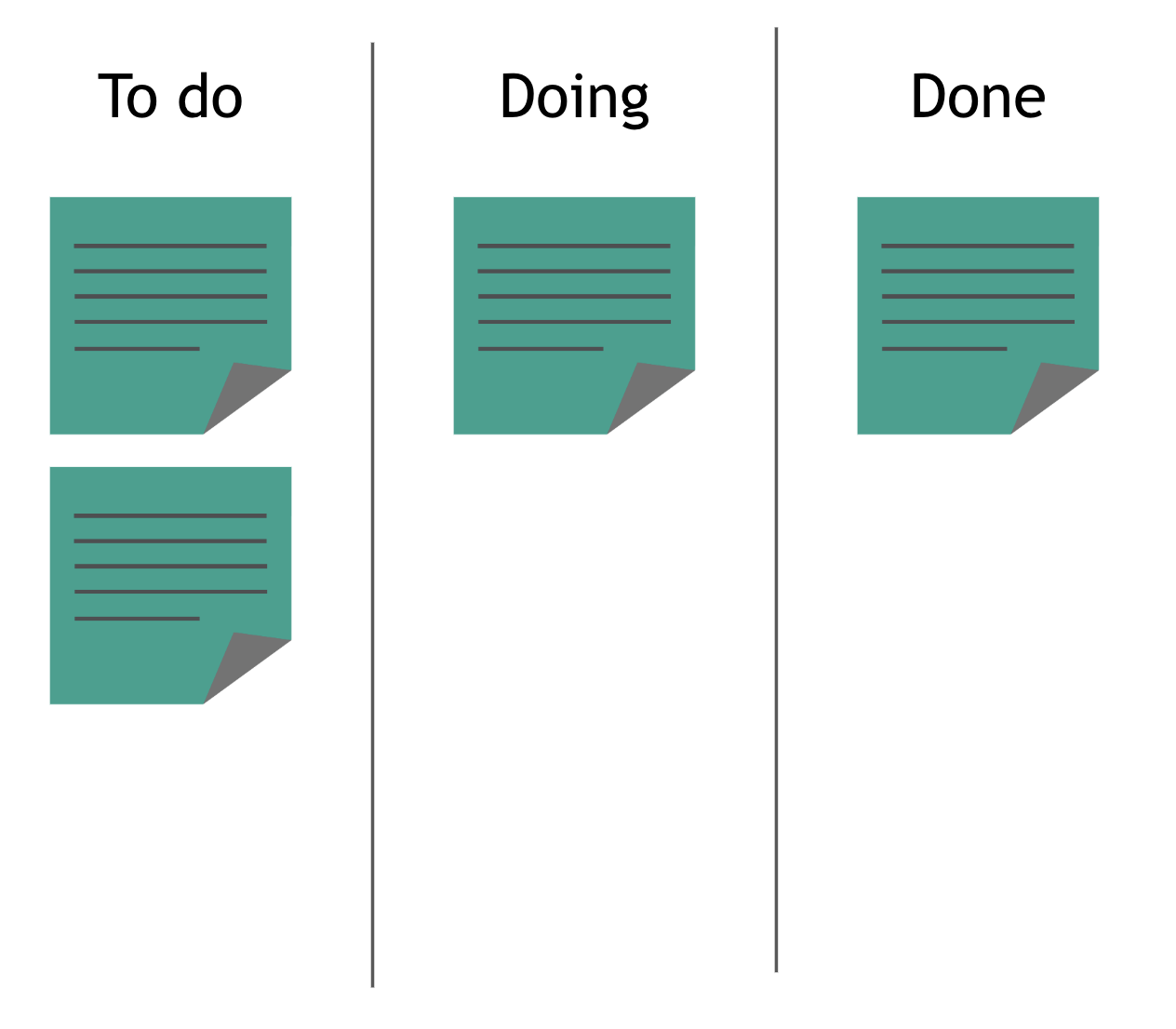The Kanban method uses the Kanban board to carry out all these steps and goes far beyond the board itself. The method helps you understand all your work, increases transparency, facilitates agreements with stakeholders, measures the work, and considerably improves your management. Through this increased management, you can make decisions that enhance your effectiveness.
Starting with the basics and then evolving
You can begin with a board in the classic format of "To Do," "Doing," and "Done," also known as ProtoKanban. Although this format offers limited management over the work, it already helps with one of the most powerful aspects of the board: visualizing all the work. In this format, we still don't know the exact stage of each task; we only know how much work we have to do, how much we're currently working on, and how much we've recently completed.

Here are some ideas to start gaining more management using Protokanban:
- Organize activities so that the items at the top are the most prioritized
- Leave space in the "Doing" area to move items forward or backward, allowing you to visualize how much of each task is completed or pending. You can even use percentage numbers to help.
- Use colors to categorize the work, whether by type of task, urgency or even by who requested the work.

With these ideas, we can notice that work management improves, and decisions about what to do and when to do it start to get better. However, we can gain even more control by including our workflow on the board and beginning to move beyond the basics.
Your Workflow Represented Visually
Let's evolve our board by adding more columns, providing better management, and improving decision-making. It is a technique from Lean that creates a visual breakdown of our workflow, also known as Value Stream Mapping (VSM). We should focus on the steps that add value to the work and are most important.
For example, a new employee hiring workflow could include the following steps: Opening Positions, Post Job, Review Resumes, First Interview, Technical Evaluation, Hiring, and Filled Positions.

Each of these steps is important in the hiring process and has several important activities that can be grouped by the main activity that has value in our workflow. For example, in the "First interview" step, we have the activities of scheduling the interview, rescheduling and canceling if necessary, conducting the interview, recording the result, and approving or rejecting a candidate. All of these activities occur, but we represent a main activity as the column name.
Then the list of approved candidates moves on to the next step of Technical Assessment, which may also involve other activities, such as exams and tests or even an interview to assess the candidate's technical capabilities.
Now we have gained a lot of management information. We have more information than before with the use of the basic framework, because before we would only know which vacancies we have to hire, which vacancies we are working on and which vacancies have already been completed. Now we know when a vacancy is at each stage. With this, we have a better idea of how long each step takes.
By using metrics, we can calculate when vacancies will be filled, how many vacancies we fill in a given time, how long each step takes, and other information. We have many more possibilities to calculate what is happening in our work.
Visualizing Bottlenecks and Waits
With a detailed workflow, we can see when one step has more work than another. There may be reasons for this, such as the step taking longer to complete or having more people working on it, leading to more tasks being handled. We need more information to identify whether it's a bottleneck or a waiting issue.
One way to gather more insight is by incorporating the representation of queues. Queues exist in our process, but they're often invisible. When a task is completed, the next step doesn't always start immediately because the person responsible might be busy. This means the task is waiting, and we call this "being in a queue."
There may be a waiting queue between "Reviewing resumes" and "First interview." For example, when working on multiple positions, some may have already been posted, and resume reviews have been completed, but the interview phase hasn't started yet. It's possible that the person conducting the interviews is still working in another position. This can happen, and it will happen at times. If there is an issue with waiting or a bottleneck, we need the queues represented to be able to identify it.
By adding queues, our board might look like this: Open Positions, Posting Jobs, Jobs Posted, Reviewing Resumes, Resumes Reviewed, Conducting First Interviews, First Interviews Completed, Conducting Technical Evaluations, Technical Evaluations Completed, In Hiring, and Positions Filled.

Notice that we now have several To Do, Doing and Done steps. For example, we have To Do of Publish Job, then Doing with the Publish Jobs step and we also have Done with the Published Jobs step. This happens with the other steps.
ANow, when there is a lot of work in the Interviews step, we will know which vacancies have already started to be worked on, which interviews are waiting for others to be completed and which interviews have been completed and are waiting for the availability of those who carry out the technical evaluation.
If it is necessary to represent more details about the interviews, we can create more columns, but evaluate the need carefully so as not to create difficulties in updating the table. It is very important to keep the table updated; when it becomes outdated, it becomes useless. An outdated table does not have even the most simple details. Balance is very important.
Managing the Flow and Going Even Further
The Kanban method has additional practices that complement what we've discussed here about visual management. One of these is limiting work in progress, which helps evaluate how much work we can handle simultaneously. We must focus on what is most important and limit excessive amounts of work, as too much work in the process significantly increases waste.
Another practice in Kanban is flow management. We can manage flow using metrics and calculations by leveraging the information from our Kanban board. We can also improve work efficiency with tools, automation, enhancing people's skills, and other methods. However, notice how each improvement can impact the flow as a whole. A change in one step can change how the other steps are executed. This is why the practice of flow management in Kanban is so important.
Improving the workflow usually brings better efficiencies than adding more people to the process. More people increase complexity, communication, and work handoffs, among other things. Improving the workflow reduces these issues. Of course, there are highly efficient workflows where adding more people is beneficial. Just as there are workflows with many inefficiencies and a large number of people, which could be more efficient, flow management will help you balance all of this.
The other practices are somehow self-explanatory: Explicit Policies, Feedback Loops, and Collaborative Improvement. Explicit policies encourage making the "rules of the game" more transparent and visible to everyone. Feedback loops are moments to evaluate the work and the flow to understand what we can improve. Lastly, the most important and most straightforward practice to understand: continuously improve, and do so with everyone's help. By collaborating, we accomplish more work. Together, we are stronger.
Keep Improving Your Management
We have seen how the Kanban method uses the Kanban board to enhance our work management, making our process/workflow more transparent and significantly increasing our decision-making capacity. Along with the other practices of the Kanban method, we gain efficiency, and with more precise information, we can be more assertive and achieve greater effectiveness
Here at Synergyc, we offer official training from Kanban University (the creator of the Kanban method), where you can further deepen your knowledge.
We can still evolve the management of our work by managing dependencies, connecting teams, and handling multiple projects at once. Keep following our articles and courses for more insights.
Deepen Your Knowledge of Kanban with Official Training
To learn more about the Kanban method, we offer official training from Kanban University here at Synergyc. These include:
Team Kanban Practitioner
Kanban System Design
Kanban Systems Improvement
With these courses, you can earn globally recognized Kanban certifications that will strengthen your resume.





